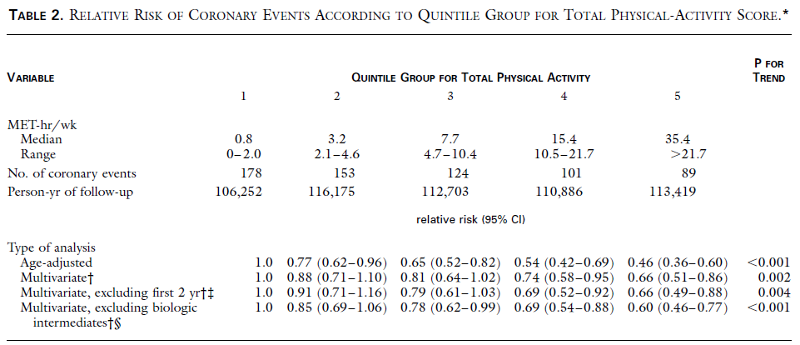Exercise
Several well done studies have demonstrated substantial benefits of exercise in reducing the risk of coronary heart disease.
Manson J, et al: A prospective study of walking as compared with vigorous exercise in the prevention of coronary heart disease in women. N Engl J Med 1999;341:650-8.
In this prospective cohort study Manson and her colleagues examined the association physical activity and coronary heart disease events in 72,488 female nurses who were 40 to 65 years old in 1986 and who had no know heart disease or cancer at the beginning of the observation period. Detailed information on physical activity was first collected in 1986 and was updated in 1988 and 1992. Participants were asked to report the average amount of time spent per week during the previous year on a wide variety of physical activities, and they used this information to calculate a "MET-hr/week" expenditure of energy, and they divided the cohort into quintiles based on their physical acclivity. During the subsequent 8 years of follow-up, there were 645 incident coronary events (nonfatal myocardial infarction or death from coronary disease). The table below summarizes their findings.
expenditure of energy, and they divided the cohort into quintiles based on their physical acclivity. During the subsequent 8 years of follow-up, there were 645 incident coronary events (nonfatal myocardial infarction or death from coronary disease). The table below summarizes their findings.

The rate ratio for each quintile was calculated using the incidence rate in the less active women (quintile #1) as the reference group. The 95% confidence interval for each rate ratio is shown in parentheses. The table demonstrates that there was an inverse relationship between activity and coronary events, and there was a clear biologic gradient. a strong, graded inverse association between physical activity and the risk of coronary events. The second multivariate analysis, which was adjusted for many risk factors for coronary disease, showed that, compared to the least active quintile, women with progressively greater activity had rate ratios of 0.88, 0.81, 0.74, and 0.66. For example, women who exercised even moderately (quintile #3) had almost a 20% reduction in risk of a severe coronary event (death or infarction). The authors further stated:
"Walking was inversely associated with the risk of coronary events; women in the highest quintile group for walking, who walked the equivalent of three or more hours per week at a brisk pace, had a multivariate relative risk of 0.65 (95 percent confidence interval, 0.47 to 0.91) as compared with women who walked infrequently. Regular vigorous exercise (»6 MET) was associated with similar risk reductions (30 to 40 percent). Sedentary women who became active in middle adulthood or later had a lower risk of coronary events than their counterparts who remained sedentary."
The authors concluded that "brisk walking and vigorous exercise are associated with substantial and similar reductions in the incidence of coronary events among women." They further stated, "These findings lend further support to current federal exercise guidelines, which endorse moderate intensity exercise for at least 30 minutes on most (preferably all) days of the week. Our results suggest that such a regimen (e.g., brisk walking for three or more hours per week) could reduce the risk of coronary events in women by 30 to 40 percent. Increasing walking time or combining walking with vigorous exercise appears to be associated with even greater risk reductions. Given the high prevalence in the United States of a sedentary lifestyle (78 percent of adults engage in less physical activity than currently recommended), we estimate, on the basis of our multivariate relative-risk analyses, that one third of coronary events among middle-aged women in the United States are attributable to physical inactivity."
Exercise or Weight Loss?
Hu FB, et al: Adiposity as Compared with Physical Activity in Predicting Mortality among Women. N Engl J Med 2004;351:2694-703.
These authors used the Nurses' Health Study to examine the associations of BMI and physical activity with death among 116,564 women. They found that higher levels of physical activity reduced the risk of death at all levels of obesity, but but did not eliminate the adverse effect of obesity. Compared to women who were lean (BMI< 25) and active (exercising 3.5 or more hrs/week), the adjusted rate ratios were:
- 1.55 (95% confidence interval, 1.42 -1.70) for lean and inactive women,
- 1.91 (95% confidence interval, 1.60 - 2.30) for women who were obese (BMI >30) but active,
- 2.42 (95% confidence interval, 2.14 - 2.73) for inactive, obese women
They concluded that both obesity and reduced physical activity are strong and independent predictors for death. Moreover, they estimated that BMI>25 and physical inactivity (weekly exercise <3.5 hours) together could account for 31 % of all premature deaths, 59% of deaths from cardiovascular disease, and 21% of deaths from cancer among nonsmoking women.


